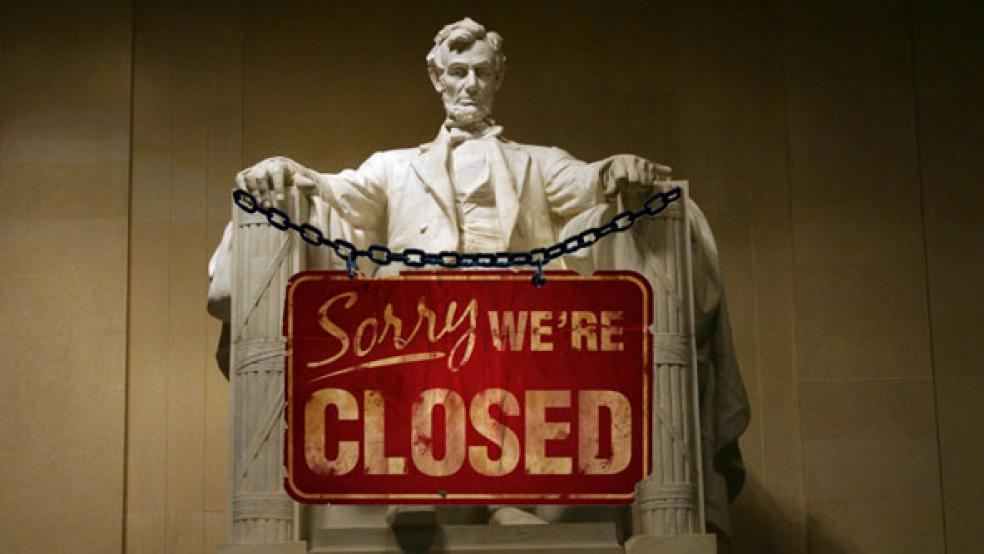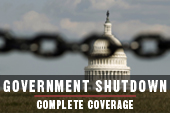As President Obama and congressional Republicans move dangerously close to a government shutdown early next week, it’s time to take stock of how a shutdown would affect federal workers, the military, government contractors and average Americans reliant on government programs and benefits.
The last two government shutdowns – in late 1995 and early 1996 – were chaotic for federal workers, posed major inconveniences for the public, and prompted a political backlash against Republicans who controlled the House and Senate at the time.
RELATED: GOVERNMENT SHUTDOWN: 13 WAYS IT CAN HURT YOU
This time may be different. Americans today are almost equally divided over the issue of culpability—with 39 percent saying they would blame the Republicans and 36 percent saying they would blame the Obama administration, according to a study released today from the Pew Research Center.
RELATED: THE 15 WORST GOVERNMENT SHUTDOWN PICKUP LINES
The dispute, this time, is over congressional Republicans’ attempt to defund the Affordable Care Act as part of a stop-gap spending bill to keep the government operating through Dec. 15.
With no deal in the offing between the Republican-controlled House, the Democratic Senate and the White House to pay the government’s bills beyond midnight Sept. 30, much of the federal government could begin to shut down when the new fiscal year starts next Tuesday.
RELATED: SHUTDOWN LOWDOWN: SIZING UP THE FEDERAL FURLOUGHS
Here are the nine most important things to keep in mind as the first government shutdown in 17 years approaches:
$150 million a day. That’s the price-tag to taxpayers for closing down the government. In 1995, the record three-week closing cost a $1.25 billion or $1.9 billion in today’s dollars.
A shutdown would not block Obamacare. House and Senate Republicans say they are willing to go to the mat to defund the Affordable Care Act. But Obamacare is essentially an entitlement program with mandatory spending. This means that – short of enacting legislation to repeal or sideline the new health care law – most of its funding is beyond the reach of a continuing resolution or CR, which relates to discretionary spending.
So, for example, the money for tax credits and Medicaid expansion would arrive on schedule. State and federal exchanges would still operate. The individual mandate would still be in place. The CR approved by the House last Friday avoids this trap by approving the text of a bill that would sideline Obamacare. Yet that measure will die in the Senate.
Uncle Sam would limp along but not collapse. Many federal agencies are deemed essential to protect life and property, or to provide benefit payments. These agencies would be allowed to operate, although their workers could not draw a salary – at least not immediately.
In the past, that has meant that employees involved with border and coastal security, protection of federal lands and buildings, the care of prisoners, law enforcement and criminal investigations, emergency and disaster assistance, the Treasury and financial system and maintenance of the power grid, were all kept on.
But plenty of services would disappear. The last government shutdowns were grim times for federal workers, with about 800,000 being furloughed.
The Centers for Disease Control and Prevention halted disease surveillance. Toxic waste clean-up work at 609 sites was halted. And while zookeepers continued to feed the pandas, the National Zoo in Washington, D.C., was closed to the public. So was the Washington Monument, the Lincoln Memorial and 368 national park sites, which resulted in the loss of some seven million visitors.
With non-essential workers on furlough, 200,000 applications for passports went unprocessed. U.S. tourism and airline industries incurred millions of dollars in losses; and more than 20 percent of federal contracts, representing $3.7 billion in spending, were affected adversely.
Social security benefits would keep flowing. Social Security is a mandatory program that would continue during a shutdown, but the entire system would be gunked up. During the 1995 and 1996 shutdowns, claims from 112,000 Social Security applicants went unprocessed, 212,000 Social Security cards were not issued and 800,000 toll-free calls for information went unanswered.
You’d still get mail. The U.S. Postal Service is an independent agency and doesn’t directly receive revenues from the Treasury, so it will continue deliveries through sleet, snow, rain and government shutdowns.
Many federal employees and contractors would work for no pay. According to an OMB advisory memo to agencies last week, employees who stay on the job would not get a paycheck at first. But they would be entitled to retroactive pay once the government is running again. This includes all military personnel.
The situation is much less clear regarding nonessential employees. They would have to come to the office on the first day of a shutdown to secure files, fill out time and attendance forms and “otherwise make preparations to preserve their work,” according to the OMB.
Contractors won’t get paid on time. Federal contractors would likely have to push back project deadlines, because the agencies that hired them wouldn’t be able to issue the necessary paperwork.
Garbage would pile up. Congress would heap one more indignity on the District of Columbia if there’s a shutdown. The city’s trash collectors would be furloughed, along with other D.C. workers whose operating budgets are approved by Congress. That’s going to be a messy situation, since D.C. produces about 500 tons of garbage each week, according to The Washington Post.







